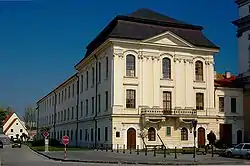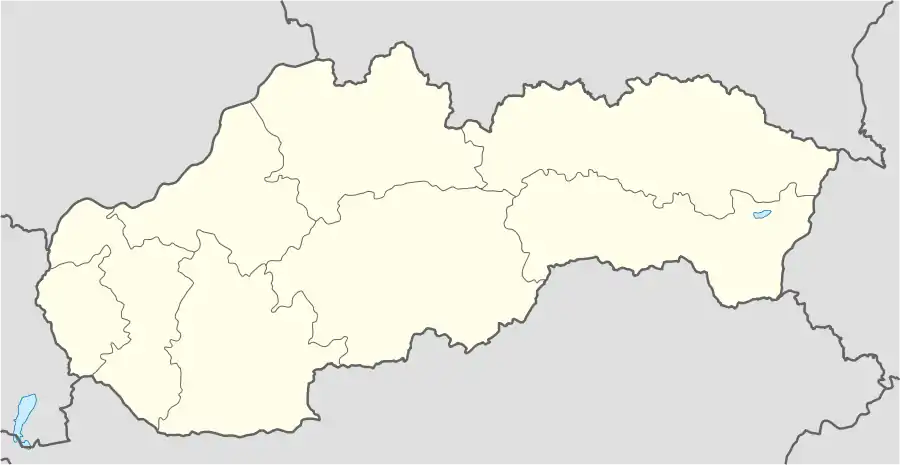University of Trnava
The University of Trnava (in Trnava) (Slovak: Trnavská univerzita v Trnave) is one of the oldest universities in Slovakia. It is based in Trnava, in the west of Slovakia.
Trnavská univerzita v Trnave | |
 | |
| Latin: Universitas Tyrnaviensis | |
| Type | Public |
|---|---|
| Established | 1635 (historical)/1992 (present) |
| Rector | Prof. PaedDr. René Bílik, PhD. |
| Students | 4,671 |
| Address | Hornopotočná 23, 918 43 Trnava , , Slovakia 48.3797181°N 17.5867669°E |
| Affiliations | ERASMUS |
| Website | truni |
 Location in Trnava Region  University of Trnava (Slovakia) | |
Historical university
The original Jesuit university was founded in 1635 by the Archbishop of Esztergom, Péter Pázmány. It had a faculty of arts, faculty of theology, faculty of law (since 1667) and faculty of medicine (since 1769). The early student body consisted mainly of ethnic Slovaks, who were then a stateless ethnicity within the Kingdom of Hungary. Within decades, the University contributed to the formation of an early Slovak intelligentsia, which began to formulate early nationalistic and ethnic demands of emancipation of Slovak people within the Kingdom.[1] The university lasted 142 years in Trnava (German: Tyrnau; Hungarian: Nagyszombat) after which it was moved to Buda in 1777 and finally to Pest in 1784. Its legal successor is Eötvös Loránd University in Budapest, Hungary. The Faculty of Theology is now Pázmány Péter Catholic University (in Budapest and Esztergom).
In the first academic year, out of forty-eight external logicians, 39.85% were Hungarian, 8.31% were Transylvanian, 4.16% were Croatian, and the same percentage represented Slavic nobility, meaning that nobles accounted for 56.48%, while the bourgeoisie represented 33.36%. There was also one libertine, two foreigners, and two with an undetermined status. In terms of territorial distribution, 52% were from Hungary, 12.5% from Croatia, 10.4% from Transylvania, 4.16% from abroad, and 22.5% from unknown locations. Since students came from various regions within Hungary, it can be said that the university became not only the university of Nagyszombat and its surroundings but also of the entire country, and its reputation reached abroad as well. (The 1637-1638 data show the same picture but with much less accuracy and more missing data.) As the researchers indicated the age of the grammar school students next to their names (eight to sixteen years old for the lower forms and fifteen to twenty-seven years old for the upper forms), they estimate the age of the graduating humanities students to be twenty-three to twenty-four and that of the theologians to be twenty-seven to twenty-eight years old.[2]
In 1997 another university was founded in Trnava, the University of Ss. Cyril and Methodius.
Present-day university
The present-day university was established in 1992 and although bears the same name, it isn't a legal successor. It currently has five faculties, 4 of them seated in Trnava:[3]
- Faculty of Philosophy and Arts
- Faculty of Education
- Faculty of Health and Social care
- Faculty of Law
and 1 in Bratislava:[4]
- Faculty of Theology
Notable staff
- Zuzana Števulová, award-winning lawyer.[5]
References
- "Ako napĺňame zmysel svojho štátu". Štandard (in Slovak). Retrieved 2023-01-27.
- Sinkovics, 1985. 40–41. o.
- "Faculties | Universitas Tyrnaviensis · Trnava University in Trnava".
- "TFTU - Teologická fakulta Trnavskej univerzity |".
- Zuzana Stevulova, migrationonline.cz, Retrieved 15 July 2016
Literature
- Sinkovics, 1985. = Az Eötvös Loránd Tudományegyetem története 1635–1985. Szerk.: Sinkovics István. Budapest, 1985, ELTE
